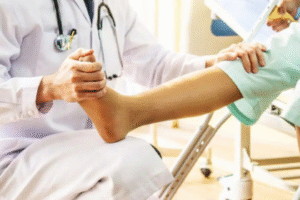
Bunions can cause pain and discomfort. They often make daily activities challenging. Yet, relief is possible with the right care. Orthopedic surgeons play a key role in treating bunions. They use their expertise to assess and manage this condition effectively. Like wrist arthroscopy Chula Vista, bunion treatment involves precise techniques. These specialists work to reduce pain and improve life quality.
Understanding Bunions
Bunions are bony bumps that form on the joint at the base of the big toe. They occur when some of the bones in the front part of the foot move out of place. This causes the tip of the big toe to get pulled toward the smaller toes. The toe joint then protrudes, forming a bunion. According to the National Institute of Arthritis and Musculoskeletal and Skin Diseases, bunions can lead to foot pain, swelling, and inflammation.
The Role of Orthopedic Surgeons
Orthopedic surgeons are trained to handle musculoskeletal issues, including bunions. They evaluate the severity of the bunion and recommend the best course of action. This might involve non-surgical treatments like padding, splinting, or physical therapy. They also guide patients on proper footwear to alleviate symptoms. When non-surgical methods do not bring relief, surgery becomes an option.
Surgical Options for Bunions
The choice of surgical procedure depends on the size of the bunion and the patient’s condition. The most common surgeries include:
- Bunionectomy: Removal of the bunion and realignment of the toe joint.
- Osteotomy: Cutting and realignment of the bone.
- Arthrodesis: Removal of damaged joint surfaces and insertion of screws or plates to hold the surfaces together.
Each of these surgeries aims to relieve pain and restore proper alignment to the foot.
Comparing Non-Surgical and Surgical Treatments
| Treatment Type | Non-Surgical | Surgical |
| Effectiveness | May reduce pain temporarily | Often resolves the bunion permanently |
| Recovery Time | None | Several weeks to months |
| Cost | Typically lower | Higher due to surgery and recovery |
| Risk | Minimal | Higher due to surgical complications |
Benefits of Surgery
While non-surgical options can offer relief, surgery often provides a more permanent solution. The benefits include:
- Reduction in long-term pain
- Improved foot function
- Better quality of life
Following surgery, many patients experience a significant decrease in symptoms. The American Academy of Orthopaedic Surgeons highlights that most patients are satisfied with the outcomes of bunion surgery.
Recovery and Aftercare
After surgery, recovery is crucial. Orthopedic surgeons provide guidance on post-operative care. This includes keeping weight off the foot, physical therapy, and follow-up visits. Recovery times vary, but most patients return to normal activities within a few months. Adhering to the surgeon’s instructions ensures a smooth healing process.
Making the Decision
Deciding to undergo surgery is personal. It depends on the severity of the symptoms and how much they affect daily life. An orthopedic surgeon provides valuable insight and recommendations. The goal is to ensure that patients make informed decisions tailored to their needs.
In conclusion, orthopedic surgeons are vital in managing bunions. Their expertise offers hope and relief to those suffering from this painful condition. With the right treatment, it is possible to lead a comfortable and active life once again.














